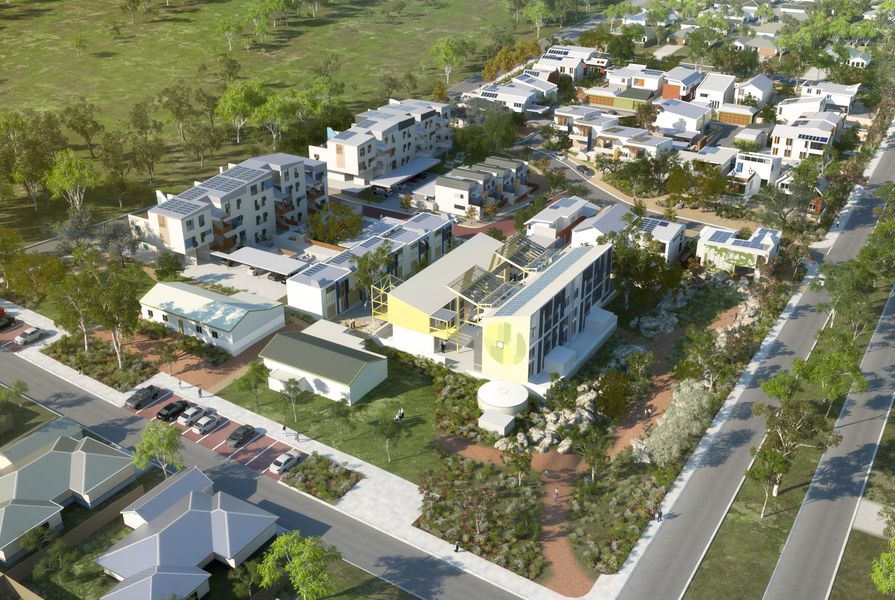WGV in White Gum Valley, Western Australia, could become the world’s first zero carbon neighbourhood by using solar photovoltaic and battery storage technologies instead of the grid.
Curtin University has partnered with LandCorp, Low Carbon Living CRC, Western Power and Solar Balance to develop the project, which will be a novel way to show how a strata neighbourhood can involve solar storage technologies.
A $1 million grant from the Australian Renewable Energy Agency (ARENA) is helping to fund the project, which is set to take place over the next three years, and will see Curtin University partner with developers on projects in every state and territory.
Using rooftop solar power the excess electricity made from the sun is stored in a battery, and this stored power is used at night. Any excess power that is not needed by the home is then put out into the grid for use by other dwellings.
Architecture practice CODA Studio worked with developers LandCorp to build a concept for an apartment and maisonette for the trial neighbourhood, located 3 kilometres from Fremantle city centre.
CODA director Kieran Wong said the design guidelines were prepared by CODA and are atypical for a development of this type, with designers being invited to take cues from the surrounding environment.
“We worked with a broad team of sustainability experts in order to deliver a project that achieved the One Planet Living standards expected by LandCorp,” Wong said.
One Planet Living is an international sustainability initiative that provides a framework, built around 10 principles, to guide sustainable development.
Currently it is difficult to get solar power into apartment buildings with shared common spaces due to there being no single owner of the rooftop area where the solar panels need to be installed.
To make renewable energy more appealing to investors the project team is looking into making solar power and battery use profitable.
Curtin Research Fellow Jemma Green said the project would see the strata acting as a quasi-utility provider, which owns and operates the solar power infrastructure and sells power directly to homeowners and tenants.
“If you’ve got an apartment you can’t put solar on your roof because you don’t own the roof, everyone owns the roof, and often apartments are owned by investors and then tenanted, and investors haven’t wanted to put renewables in because they have to pay for it but the tenant gets the benefit,” Green said.
The ultimate goal of the project is to develop a national framework that allows apartment buildings to install renewable energy.
Green said strata currently make up about 28 percent of the housing supply in Australia.
“Although in Australia we have 1.5 million houses with rooftop solar, we hardly have any strata with rooftop solar because the roof is owned by the body corporate and they are investor owned and tenant occupied,” she said.
The project will be rolled out one state or territory at a time, and will adapt each government’s framework. Green said they would be looking for projects that are in the late design stages and about to start construction that would be willing to add in solar panels and batteries.
As a result Green hopes to see more deployment of renewables in the strata part of the property market, with new buildings adding solar panels to their roofs, but she also thinks retrofits could be a big market, despite this being a bigger challenge.
Retrofits require everyone in the building to agree to the solar panels and batteries, and if a sink fund for the apartment block is not available this money would need to come from each homeowner.
The research program will take place over three years but Green said she hopes to have most of the developments completed in the first 18 months.
The first WGV building has three apartments and will be completed by October, with three other buildings that will be finished mid-next year.
The project has received two Planning Institute of Australia awards for excellence in 2015, including Best Planning Ideas – Small Project and the Planning Minister’s Award.
Rooftop solar power has become an area of interest for start-up companies that have seen business potential in the rental industry.
Simon Barnes and Chris Mrakas co-founded a company called Matter, which has developed technology that monitors individual use of solar power in real time and then bills the tenant and remits payments to the landlord.
According to The Age, the newly launched digital solar service can provide solar power to tenants for about 9 cents a kilowatt-hour and leave a margin for landlords to repay their investment in solar panels.
The technology can also be used to deliver other services such as managing battery storage systems to allow people more value from their solar panels, The Age reported.
Barnes and Mrakas plan to get their technology in use in Australia before offering it to the rest of the world.

















